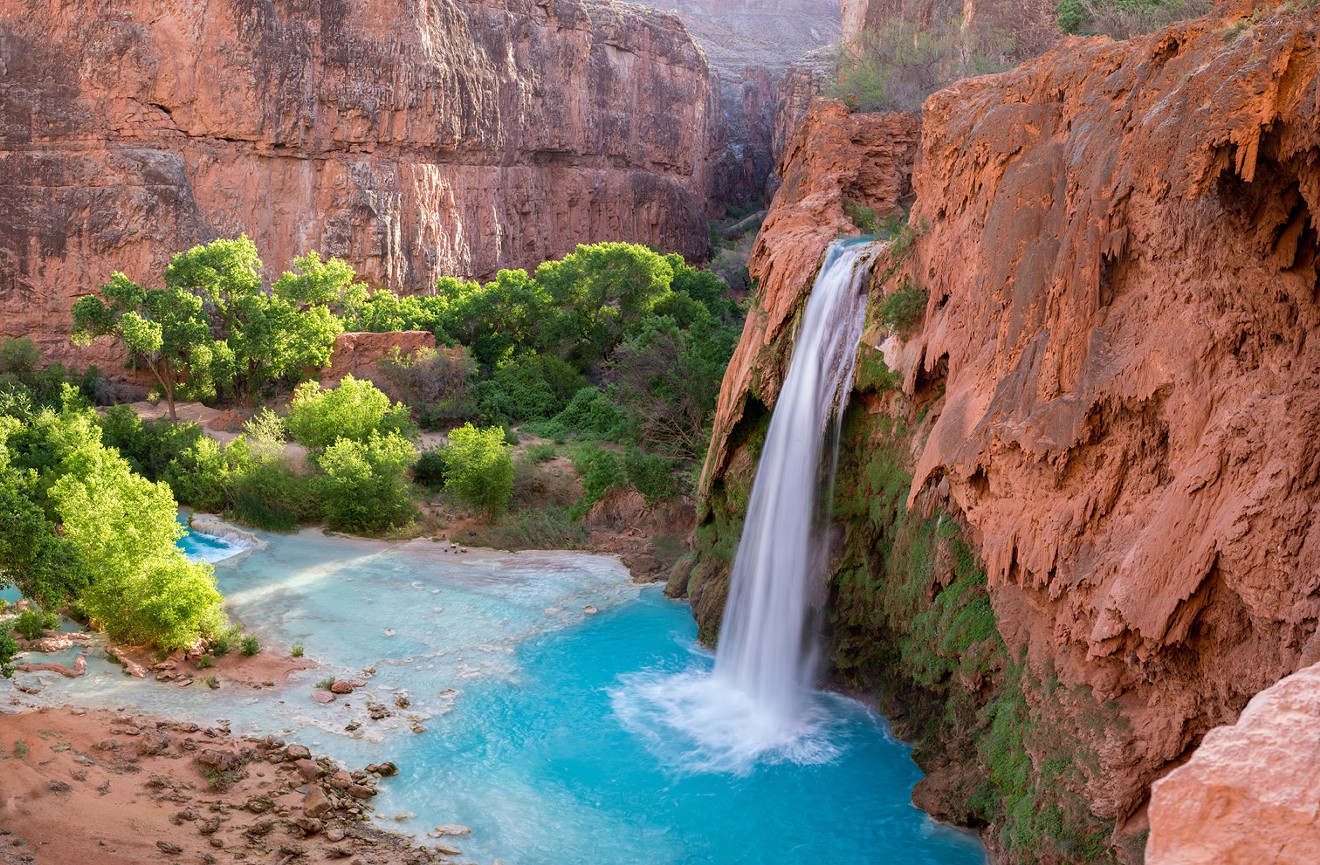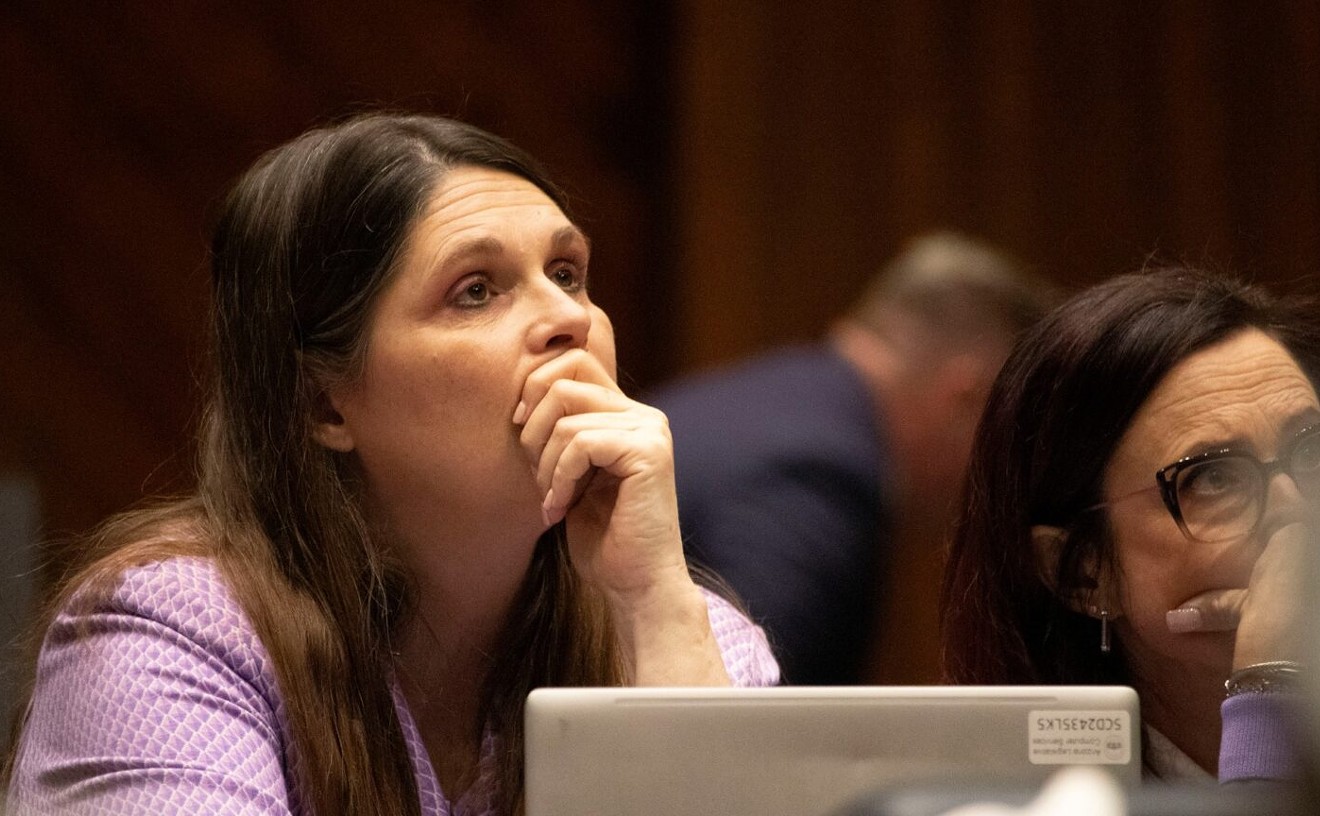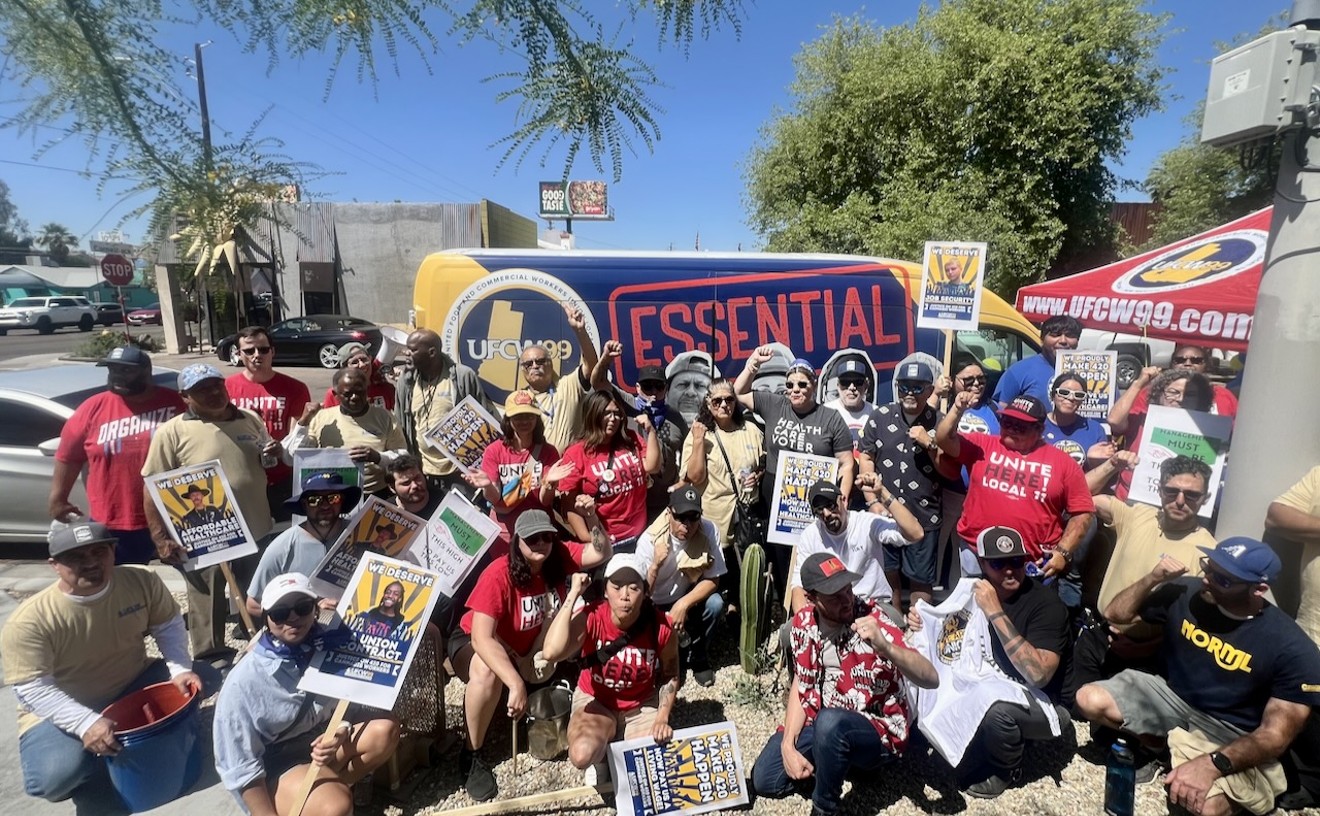Look at the Arizona landscape, and thousands of years of history look back. Those Instagram-ready crags of the Grand Canyon were formed by howling winds and crashing waves. Phoenix’s suburban homes and sprawling interstates were once the domain of the ancient Hohokam people, who carved irrigation canals to eke out life in an unforgiving desert.
If you’re a person with a healthy sense of your own insignificance, geologic time can be unsettling. The mountains, deserts, and river flats stare at you cold and unblinking: We were here before you; we’ll be here long after you’re dead.
The environment, water, and public lands are etched into life in Arizona. The Grand Canyon is on the license plate, the vistas of the Sonoran Desert are a short drive away, and even the city dwellers in Phoenix can easily hike Camelback Mountain or Piestewa Peak. When temperatures hit 100 degrees like clockwork and your brain starts to melt under the merciless sun, you’re forced to consider how we sustain life here.
As Earth Day 2018 approaches on Sunday, the timeless questions of how we manage land, air, and water in Arizona feel more urgent than ever. A sharp turn in federal policymaking is causing alarm among conservationists, who warn that Arizona’s landscapes and waterways aren’t as immutable as they seem.
“When you lose it, it’s gone,” said Sandy Bahr, the director of the Arizona chapter of the Sierra Club. “You can’t get it back.”
When Donald Trump was elected president, environmentalists in Arizona were immediately on edge. Like other conservationists around the nation, they thought his federal appointments and policy positions were egregious.
Trump appointed former Oklahoma attorney Scott Pruitt, anti-Environmental Protection Agency warrior, to head the very agency he sued 13 times. Last June, Trump pulled the U.S. out of the Paris Climate Accord, with potential for increasing temperatures acutely in the Southwest. And environmental groups warn that Trump’s plans for a wall could be devastating for wildlife and public lands along the U.S.-Mexico border.
The environmental rollback at the federal level is especially troubling in Arizona, where the state government is keen on deregulation. Conservationists say state agencies prioritize commerce and industry groups over muscular protections for the environment. Although in the past the EPA served as a kind of backstop to an anti-regulatory state government, under the Trump administration, Arizona agencies and the Legislature may have a free hand.
“We’ve got so much here, and it seems like some of the people we elect are hell-bent on destroying it. That means that we have a lot of work to do,” Bahr said.
Bahr has led the Arizona Sierra Club for 20 years. When she was just a volunteer with the Sierra Club in 1992, Bahr helped lead a ballot initiative to reject a law on “regulatory takings” — the concept where Arizona would have to compensate people whose property was devalued by new rulemaking. Opponents described the measure as an underhanded attempt to stymie environmental regulations. The Sierra Club won — the law was defeated at the ballot box in 1994.
The experience made her realize the power of citizen initiatives, Bahr said. “I became a fan of those provisions in our Constitution where we can stop things by taking it out to the people and getting the signatures,” she said.
And if the past year under the Trump administration is any indication, there will be plenty of fights to be won and lost in the future.
As far as federal agencies go, the Department of the Interior is pretty dull. Previous heads of the department have been no-drama bureaucrats like the CEO of outdoor-gear store REI and the former attorney general of Colorado. The agency’s seal is a sleepy-looking bison.
But in fall 2017, an easily forgotten department became the focal point of intense controversy in western states like Arizona. It all began with an ominous proclamation on national monuments.
A year ago, Trump signed an executive order directing federal agencies to review more than two dozen national monuments created since 1996 under a 1906 law, the Antiquities Act. Trump said that creating these monuments amounted to an “egregious abuse of federal power.”
“Today, we are putting the states back in charge,” Trump said in his remarks before he signed the order.

Four national monuments under Zinke’s review are located in Arizona: Grand Canyon-Parashant, Ironwood Forest, Sonoran Desert, and Vermillion Cliffs. In response to Trump’s order, Zinke submitted to the president a stark survey of national monuments he thought ought to be modified or reduced in size. Ultimately, the administration slashed two Utah monuments, Bears Ears and Grand Staircase-Escalante, greatly reducing their boundaries.
As a result, the lands may be open for a number of new uses, including industry, recreation, or cattle grazing. Zinke left the other monuments on his list unchanged — for the time being. Conservationists began to refer to the monument review as “Zinke’s hit list.”
But some Arizona politicians were pleased to see the Interior Department apply scrutiny to the national monuments. Arizona Congressmen Andy Biggs, Paul Gosar, and Trent Franks (now resigned) signed a letter with other House members that urged Zinke to eliminate or reduce various national monuments. The representatives recommended a “total rescission” of Arizona’s four national monuments on Zinke’s list.
In an email, Interior Department spokesperson Faith Vander Voort wrote that claims by environmentalists “are false and deliberately misleading.”
“The Secretary is opposed to the wholesale sale or transfer of federal land, and at no point did the monument review result in the sale or transfer of federal land,” Vander Voort wrote. “All land that was no longer within the monument boundary remained public land and is open for public use. The land and any cultural resources that may be contained on the land are still under strict federal protection.”
The Interior Department has no plans to revisit the four Arizona monuments that were included in the review, according to Vander Voort.
All the same, conservationists are concerned by the Department’s new direction.
Kierán Suckling, the founder of the Tucson-based Center for Biological Diversity, said that many threatened species of plants and animals depend on public lands. Opening up these areas to private interests puts them at risk, he says. After public lands leave the hands of the federal government, their fate can be hard to predict.
“Once those decisions are made, they’re very difficult to reverse,” Suckling said. “And so the Trump administration has the power to set in motion the destruction of tens of thousands of acres on our public lands that the next president, even if they were a favorable person, would be very hard-pressed to reverse.”
Conservation groups and tribal communities successfully convinced Obama’s Interior Secretary Ken Salazar to enact a 20-year ban on new uranium mining claims in the Grand Canyon region in 2012.
“It was a big win,” said Amber Reimondo, the energy program director for the Grand Canyon Trust in Flagstaff. The moratorium gave the Grand Canyon Trust the “peace of mind” that no new mining claims would mar the landscape or potentially contaminate the watershed for at least two decades, she explained.
After all, the Grand Canyon is a national jewel and holds special importance for the Native American communities in the region, especially the Havasupai Tribe. Putting a stop to new uranium claims in light of the mining industry’s painful and destructive history was a no-brainer.
“I mean, it’s the Grand Canyon,” Reimondo said matter-of-factly.
Then the election happened. In a report released last November, the U.S. Forest Service recommended revisiting the Grand Canyon mining ban in response to another Trump executive order, this time directing federal agencies to maximize domestic natural resources within their jurisdiction.
But as Phoenix New Times reported in January, the global market has plenty of uranium, prices are low, and the U.S. has a huge stockpile of the mineral. There’s very little need to haul more uranium out of the ground for the purposes of energy independence or national security. Reopening the Grand Canyon region to uranium mining, Reimondo argues, was never about resource stockpiles or energy policy.
“The concern here, I think, is that this isn’t really about national security,” she said. “It’s about these private companies making a quick buck while they can.”
The Grand Canyon Trust is one of several organizations suing the Trump administration over the monument reductions in Utah. The Trust has also sued unsuccessfully to prevent an energy company from opening the Canyon Mine, an existing uranium claim near the Grand Canyon’s south rim.
It’s ironic. Zinke has put several Arizona monuments on the chopping block even though the state has a reputation as a tourism haven. Millions of visitors pour into Arizona every year, arriving to gawk at the Grand Canyon, the red rocks of Sedona, and the Petrified Forest, bringing their wallets and boosting the state’s economy.

The Morrison Institute at Arizona State University, along with the Nina Mason Pulliam Charitable Trust and the Arizona Republic, found that 72 percent of Arizonans felt that parks and open spaces were “very important.”
In that sense, Bahr said that the rollback on public lands signals a worrying gap between government and its constituents. If you talk to Arizonans, she said, they’ll tell you that they love public lands, national forests, and parks. But Washington policymakers and their boosters in Arizona evidently aren’t listening to the conservationists and outdoors types who want to preserve natural places.
“It’s not representative of the people,” Bahr said. “I feel like the whole representative democracy has broken down.”
As fights play out over public lands in Arizona, interest groups are waging pitched battles over climate change and the atmosphere. Although they have niche strategies, Arizona’s various environmental groups universally agree that climate change is a looming challenge. And right now, conservationists say that the state isn’t doing enough to reduce greenhouse-gas emissions.
This month, the policy center of Environment Arizona released a report that shows Phoenix trailing behind Los Angeles, San Diego, and Honolulu among cities with the most installed solar-energy capacity. Bret Fanshaw, a senior advocate with the organization, said that although Phoenix’s progress toward renewables is exciting, Arizona’s renewable-energy goals lag behind California and Colorado.
“We’re still only barely just scratching the surface of what’s possible,” Fanshaw said. “And so we’re encouraging officials — at the local level and at the state level — to increase our commitments to renewable energy because there’s so much more that we can do.”
Heavyweight interests on both sides of the debate have clashed this year in a bare-knuckle political brawl over renewable power in Arizona. A clean-energy group with ties to billionaire Democratic donor Tom Steyer called Clean Energy for a Healthy Arizona is seeking to amend the state constitution to guarantee that Arizona’s public utilities generate half of their power from renewable sources like wind and solar by 2030.Heavyweight interests on both sides of the debate have clashed this year in a bare-knuckle political brawl over renewable power in Arizona.
tweet this
Conservative opponents are incensed. Portraying Steyer as a deep-pocketed California boogeyman, they argue that if the initiative succeeds, Arizonans could be forced to pay higher costs for electricity.
The state’s largest utility, Arizona Public Service, has opposed the clean-energy initiative. In an emailed statement, APS said that the ballot measure “will dramatically increase electricity bills, kill thousands of jobs, eliminate millions in tax revenue, potentially increase carbon emissions in Arizona, and make our state a less attractive place to do business.”
On March 23, Governor Doug Ducey signed a bill that allows utilities to pay a miniscule fine (in some cases, just $100) if they violate clean-energy provisions of the constitution. During the debate over the bill, APS lobbyist Rod Ross told a State Senate committee that the utility proudly worked with Representative Vince Leach to draft the measure. Ross described their efforts as an attempt to “protect the people of this state from an out-of-state initiative funded by a California billionaire.”
“I have to ask, if the paid consultants and supporters of this initiative are so concerned about clean energy, then why would they exclude the Palo Verde Nuclear Generating Station, which is the largest source of clean energy in the country?” he asked the Senate government committee.
“Everyone knows that if the cost of noncompliance is cheaper than the cost of compliance, entities will serve their shareholders, not consumers, and will take the low road and pay the fines,” Bahr said.
Pollution from fossil fuels poses health risks, Bahr explained. In addition to helping stave off climate change, pushing utilities to acquire renewable energy sources will be an economic and public-health boon for regions in Arizona that phase out dirty fuels.
Environmentalists argue that the utilities’ fierce opposition to the clean energy amendment is part of their broader foot-dragging on renewable energy. They point to a decision this spring from the Arizona Corporation Commission, which regulates utilities. In March, the commission voted not to acknowledge a resource plan from three power companies, including APS, that relied too heavily on natural gas at the expense of renewable energy.
Jill Hanks, an APS spokesperson, said that about half of the utility’s energy mix comes from carbon-free energy, including nuclear power from the massive Palo Verde station. The Clean Energy for a Healthy Arizona campaign left nuclear energy out of the category of renewables in the language of the constitutional amendment.
Fanshaw, who also opposes nuclear energy because of risks surrounding mining and nuclear waste, said that these fights show Arizona utilities are “not very serious in investing in renewable energy, and need more direction in making that future possible.
“We have a lot to gain by switching to renewable energy, and we have a lot to lose if we don’t,” Fanshaw said.

The thermometer at Sky Harbor ticked up to 100 degrees on April 10, notching the first triple-digit temperature of 2018 in Phoenix. And while hot temperatures are nothing unusual, climate change will uniquely affect the Southwest.
Scientists say that as we continue to pump greenhouse gases into the atmosphere, we will experience more extreme weather events. Wildfires and droughts will get worse. In an already-warm desert environment, hotter days will strain the Valley’s water supply, which is carefully monitored, but nonetheless limited.
“All of the simulations and the mathematical models that predict climate for the future agree that the Southwest is going to get warmer and drier, while the northern part of the country is going to get warmer and wetter,” said Osvaldo Sala, a professor at ASU’s School of Life Sciences and the director of the Global Drylands Center.
The Trump administration has sought to rescind measures to combat climate change — a hoax, Trump famously called it. EPA administrator Scott Pruitt rescinded the Clean Power Plan last October, scuttling a rule that would have required power plants to reduce carbon emissions.
Even as the federal government pulls back from this signature effort to rein in climate change, scientists say that the effects of climate change are happening now.
A warmer climate will change life in Arizona, and by some measurements, longer and more brutal heat waves have already arrived. Last year was Phoenix’s warmest on record. From August to December, Phoenix had 103 consecutive days without rain, the 20th longest dry spell of all time, according to the National Weather Service.
Fires will be a persistent danger, should temperatures continue to climb. As Arizona edges toward the summer, there is an abundance of fuel on the ground after an especially dry winter and spring. Last week, the NWS forecast an elevated fire season for May and June, and showed a map of Arizona with huge patches of scarlet to represent the areas at risk. Wildfires scorched the Prescott National Forest and much of southern Arizona last summer.
The climate models and predictions for the future of the Southwest raise an alarming question: How much hotter can Phoenix get?
It’s an area of genuine concern, Sala said. “There is no doubt that our planet is getting warmer, and in my view this is the biggest challenge of this generation,” he said.
Climate change is by its nature a global problem, so even if we eschewed fossil fuels entirely and tapped into renewable energy for 100 percent of our power, Arizona can’t solve the problem unilaterally — especially under a new presidential administration that won’t acknowledge climate change. “We need to contribute to reduce our emissions,” Sala said. “But it’s not something that we can solve alone. It’s something that we can contribute to either making it worse or better.”
Name an issue — climate change, energy, public lands — and in the new political moment, Arizona seems to be careening toward an uncertain future. The political battles feel more charged. The stakes feel higher. Actions that would have been unthinkable in the past have come to pass: The president using his power not to establish national monuments but to reduce them; the EPA administrator in charge of the very agency he has spent his career battling.
Even as we rewrite our expectations of how environmental fights play out, it’s difficult to envision the future.
It could be a dark world where 120-degree days are the norm in Phoenix every summer, where rivers and reservoirs run dry, and where industries drill and blast every ounce of ore from the ground. Or maybe it is a future where our homes and vehicles run on a boundless supply of clean energy, and the careful conservation of resources makes Phoenix livable for the next two, three, and four generations.
Neither future might come to pass. But the pessimist’s nightmare vision, no matter how unlikely, is enough to give you pause.
Some scientists refer to the current geologic era as the Anthropocene. They argue that the Earth’s surface, animal life, and atmosphere have been so profoundly altered by human activity that we ought to call this a new epoch, anthro meaning related to humans. Semantics and scientific infighting aside, the debate is really one over how we mark the seconds and minutes of an ancient geological clock.
Maybe the first civilizations to set foot in Arizona thought about these questions, too, when they cast their eyes on the Grand Canyon. Who gets to govern the land, water, and air? How do we carve out a life in the desert? What kind of world will we leave behind, long after we’re gone?
















